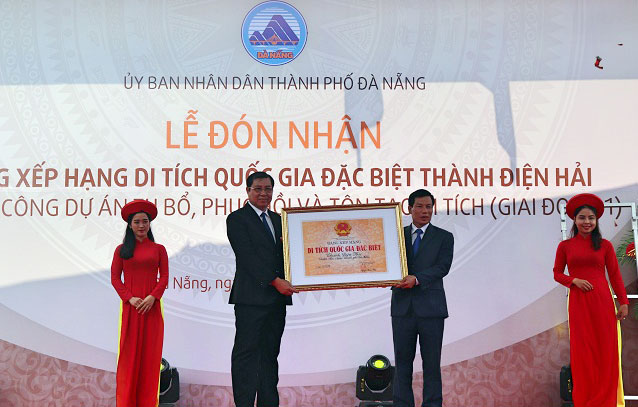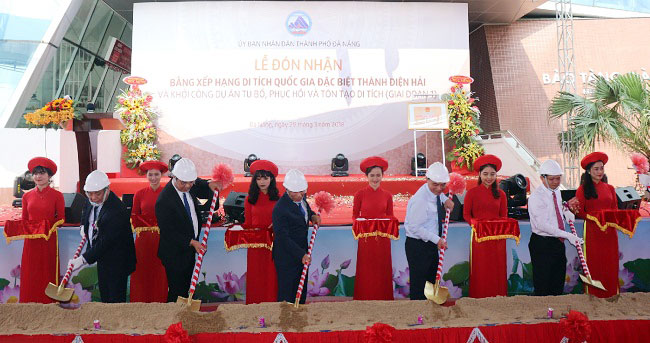Dien Hai Citadel receives certificate of recognition of special national-level relic site
On Thursday, the Dien Hai Citadel received a certificate of recognition of a special national-level relic site from the Ministry for Culture, Sports and Tourism. To mark the 43rd anniversary of the liberation of Da Nang (29 March), work started on the 1st stage of a project featuring the restoration and embellishment of this venue.
 |
| Minister for Culture, Sports and Tourism Nguyen Ngoc Thien presenting the recognition certificate to municipal People’s Committee Chairman Huynh Duc Tho |
The work is scheduled to be completed by late October at a total cost of over 102.7 billion VND (over 4.4 million USD).
Of this, 80 billion VND (3.5 million USD) will be earmarked for compensation for the displaced families, whilst the remainder will be spent on restoring the damaged walls and trenches, building water supply and drainage systems, creating tree-covered areas and a parking lot, plus other auxiliary facilities.
 |
| The ground-breaking ceremony for the 1st stage of a project featuring the restoration and embellishment of the citadel |
In attendance at yesterday’s event were Minister for Culture, Sports and Tourism Nguyen Ngoc Thien, municipal Party Committee Secretary Truong Quang Nghia, and other city leaders.
Addressing the event, municipal People’s Committee Chairman Huynh Duc Tho remarked the over 160-year-old citadel is vivid evidence of the undaunted courage and indomitable fighting spirit of Da Nang’s soldiers and its residents during their historic battles against the French-Spanish coalition forces in the 1858 - 1860 period.
Situated on the western side of the Han River, the Vauban-style Dien Hai Citadel had 2 gates, the main one facing south and the other facing east.
The citadel was one of the most important fortresses in Viet Nam in the 19th century, and was recognised as a national historical relic on 16 November 1988 by the Ministry of Culture and Information.
After nearly 200 years, most of the Dien Hai Citadel has now been destroyed by war and time, and only a few relics are left, including its walls on the west and east sides and two 19th century cannons from the Nguyen Dynasty. The remains of the citadel are located at 24 Tran Phu Street, Thach Thang Ward, Hai Chau District, and the Museum of Da Nang incorporates the reconstructed walls of the citadel.
Fully aware of the great significance of the citadel in the spiritual and cultural life of the city, since 2016, the municipal authorities have taken effective measures to conserve and uphold the tangible and intangible cultural values of this venue.
Since the start of this year, a total of 80 local families living near the citadel’s western walls have moved out of the site to their new residential areas.
In addition, the construction of a storage centre in the northern side of the citadel has also halted.
The Museum of Da Nang will be moved out of the citadel site to the current headquarters of the municipal People’s Council at 42 Bach Dang, and the Cultural Square will be constructed, the citadel being at the central position.
Chairman Tho hoped that, the citadel will help to educate the local younger generations about the spirit of ardent patriotism.
In addition, once completely refurbished, this site is expected to be one of the city’s most attractive destination for both locals and visitors, especially those who show keen interest in conducting their historical and cultural research activities.
Minister Thien asked the city to develop its master plan for the preservation, embellishment and promotion of the values of the citadel in association with the local socio-economic development, and then submit it to the Prime Minister for approval.
Special heed should be paid to create links between the citadel and other relic sites in Da Nang and neighbouring localities.
Professor Vu Minh Giang, the Vice Chairman of the National Cultural Heritage Council and the Viet Nam Association of Historical Sciences, highlighted the significance of recognition of the citadel as a special national-level relic site in marking an important turning point for the promotion of this site’s image, and accelerating the progress of the city’s tourism and culture.




